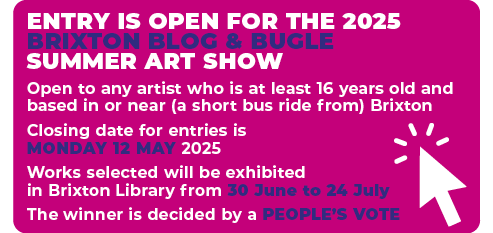WINDRUSH SQUARE, BRIXTON

It’s seven-thirty on a Sunday morning. Clubbers cluster
around the tube station, aiming to take the first train home.
A bust of Mr. Tate, founder of the library on one side of
the square, and once a leading member of the slave trade –
gazes down at a Caribbean lad asleep on a bench.
Down the aisle from me in a supermarket, a young woman
examines the label on a can of soup. She turns to the man
who is with her: ‘It’s too lumpy for how I’m feeling today.’
Back on the street, I pass a woman with her arms looped
over a broom-handle, like Christ carrying his cross; she
chatters away, a battered beer-can pressed to one ear.
Four men seated in a parked car, look out of the window,
then at each other, then out of the window again. They
are evidently waiting for someone.
A sign in the square, newly erected by the police, reads:
‘From April 24th to the 31st, 22 people were arrested for
buying drugs in this area, and 4 people for dealing drugs’.
Someone has added with a red felt-tip pen: ‘1000 people
were killed in the Sudan today. Who gives a fuck.’



Good poem. But please note the Centre for the Study of the Legacies of British Slave-ownership says: “Neither Henry Tate nor Abram Lyle was born when the British slave-trade was abolished in 1807. Henry Tate was 14 years old when the Act for the abolition of slavery was passed in 1833; Abram Lyle was 12. By definition, neither was a slave-owner; nor have we found any evidence of their families or partners owning enslaved people.” So it is incorrect to call Tate “a leading member of the slave trade”. He served a 7yr grocery apprenticeship before setting up a shop. It wasn’t until 1859 that he joined a sugar refinery co, gaining control of it ten years later.